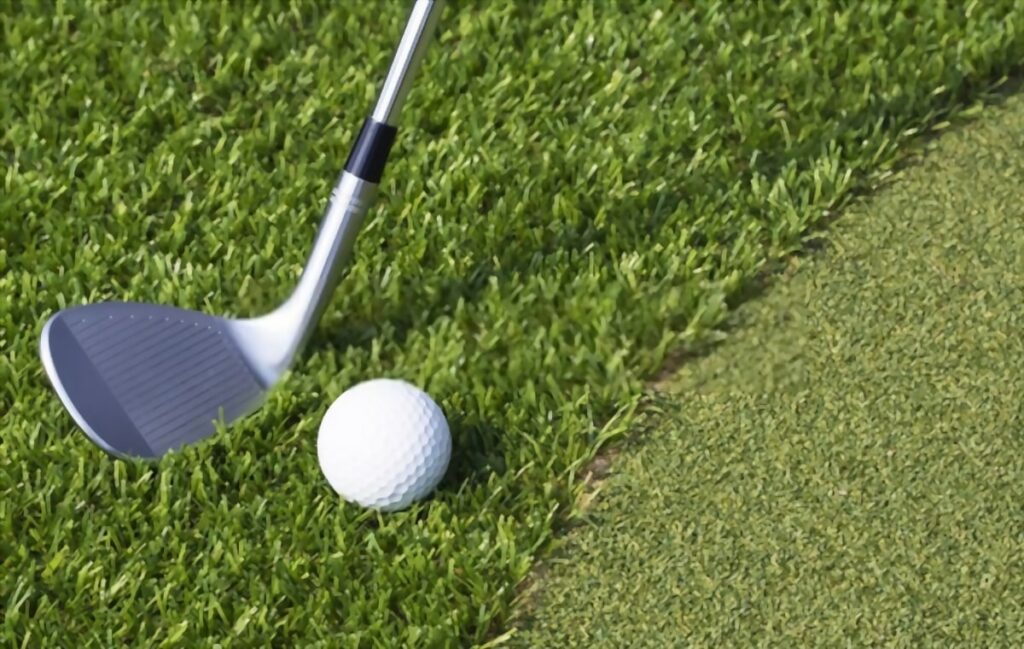The lob wedge splits opinion. While some golfers are comfortable with the high level of loft, others can find it seemingly impossible to strike consistently.
With a 60 degree wedge, the high loft angle exposes the leading edge to potential fat and thin shots — less glamorously known as duffs and skulls.
In this article, you’ll learn how to hit a 60 degree wedge.
I’ll cover the two primary use cases: pitch shots, and bunker shots. For each, you’ll discover the ideal technique to help you in any scenario on the course.
How to Hit a 60 Degree Wedge
In general, when hitting a 60 degree wedge you want the ball to be slightly forward of the center of your stance. This allows you to use the bounce of the wedge to glide the club under the ball when hitting pitch and bunker shots with the club.

As a versatile club, 60 degree wedges can be used for various shots around the golf course depending on the scenario. Most of the time, this includes:
- Long pitch shots
- Short pitch shots
- Bunker shots
Let’s explore how to hit a 60 degree wedge for each of these shot types.
1. Long Pitch Shots
Typically, the average full-swing 60 degree wedge will travel about 80 yards.
But, you’d be best advised to not hit too many full shots with your 60 degree as the high loft angle makes it difficult to strike consistently well with a full swing.
Instead, most golfers would be better suited to hitting a 52 or 56 degree wedge with less swing speed. These wedges are easier to strike from a longer range.
That said, lob wedges can be useful for pitch shots of around 30 to 80 yards.
Lob wedges can be useful for short approach shots into greens, particularly when the target landing area is small. The extra loft of a 60 degree produces a high ball flight and plenty of spin, helping the ball stop quickly when it (ideally) hits the green.
Ultimately, if you’re comfortable hitting full-swing wedge shots then a 60 degree can be a great option. Alternatively, use a lower-lofted wedge and reserve the lob wedge for scenarios where the additional trajectory and spin rates are vital.

How to Hit Long Pitch Shots With a 60 Degree Wedge
First, hold the club with a standard golf grip.
To do this, hold the grip in your fingers and either interlock or overlap your bottom hand pinky finger with your top hand index finger. The “V’s” between your thumb and index fingers should point roughly toward your right ear.
Next, stand with your feet shoulder-width apart, with the ball just forward of center.
If the ball is positioned too far back in your stance, it will encourage a steep angle of attack into the ball. This is bad for wedge shots, as it causes the sharp leading edge of the club to dig into the ground — resulting in fat or thin shots.
Instead, by positioning the ball about a “ball and a half” in front of center in your stance, you will be able to swing into the ball with a fairly shallow angle of attack.
Then, make sure to swing with plenty of upper body rotation and width.
While the distance is shorter than with an iron shot, you still want to make use of the body in a full wedge swing. This means generating shoulder turn in the backswing and rotating through the ball with your hips and upper body in the downswing.
PRO TIP: A full wedge swing is effectively the same as an iron swing.
In the video below, Robin of Top Speed Golf demonstrates the technique for full-swing wedge shots. While he uses a 56 degree, the advice applies to 60 degree wedges.
2. Short Pitch Shots
In many cases, a lower-lofted club is preferred to chip the ball onto the green.
Why? They’re easy to hit. Even pros like Rory McIlroy recommend a bump-and-run shot to chip the ball close to the pin when there is plenty of green to work with.
But, when there is very little green to work with — you need to hit a pitch shot.
While a chip shot has a low trajectory and mainly travels along the ground, a pitch shot has a higher trajectory to keep the ball in the air for longer.
When you need to land and stop the ball in a smaller area, you need more loft. A 60 degree wedge can generate enough height to get the ball to land softly.
Also, more loft equals more spin. Therefore, a high-lofted lob wedge can add plenty of spin to a pitch shot, giving it a better chance of stopping quickly on the green.
The extra spin also helps when chipping into a green sloping away from you, when it would be virtually impossible to stop the ball with a bump-and-run shot.

How to Hit Short Pitch Shots With a 60 Degree Wedge
First, grip the club as you would for a full-swing wedge shot.
Keep the grip in your fingers rather than your palms, and hold the club with about 50% grip pressure. This allows you to maintain plenty of feel through your hands.
Next, stand with your feet shoulder-width apart, with the ball just forward of center.
This setup will encourage the club head to glide under the ball, utilizing the bounce on the sole of the club to prevent the leading edge from stabbing into the turf.
PRO TIP: Wedge bounce is vital. In soft conditions, more bounce will stop the leading edge from digging in — preventing fat or thin shots.
Hold the club with the shaft fairly neutral, and the sole square to the ground.
If you have too much shaft lean at address, the clubface is effectively delofted. It also exposes the leading edge, risking the dreaded fat or thin shot.
Keep your trail arm locked into your chest, and make a short swing.
For a short pitch, you only need a short swing. By locking your trail arm — from elbow to shoulder — into your chest, you can guide the momentum of the club into the ball.
For more height, hit a lob shot by opening the clubface and widening your stance.
This enables you to slide the club head under the ball, popping it up and over any obstacles between you and the green — and landing even softer than a pitch.
In the video below, Danny Maude shows how to pitch with a 60 degree wedge:
3. Bunker Shots
And finally, the lob wedge is a highly effective club for hitting bunker shots.
While a sand wedge typically has around 54 to 56 degrees in loft, the 60 degree lob wedge is often better out of the sand in the following scenarios:
- Greenside bunkers
- High-lipped bunkers
With greenside bunkers, you often want to get the ball onto the green and stop fairly quickly. This means you’ll need as much loft as possible for higher launch and spin.
As for high-lipped bunkers, you simply need enough loft to clear the lip. While a lower-lofted wedge might catch the lip, a 60 degree can provide the extra height needed.

How to Hit Bunker Shots With a 60 Degree Wedge
The first step is to open the clubface, then regrip the club.
With bunker shots, you’ll want as much loft as possible in order to splash the ball out of the sand and onto the green. Opening the face allows it to point almost directly up, with an effective loft angle closer to around 70 to 80 degrees.
Next, take a wide stance and position the ball forward of center.
When hitting out of the sand, your aim is to strike a few inches behind the ball. In effect, you are splashing the sand out — the ball happens to ride out on the pillow of sand.
Taking a wide stance offers you plenty of balance in the shot. And, positioning the ball in front of center will encourage the swing path to bottom out before the ball.
With 60% of your weight on your front foot, swing the club around your body.
It’s important to swing around the body to keep the swing shallow, as this will help the club head glide through the sand under the ball without digging in.
In the video below, Peter Finch shares how to hit bunker shots with a lob wedge:
Conclusion
In summary, there are several ways to hit a 60 degree wedge depending on the shot required for the scenario. This includes long and short pitches and bunker shots.
- Long pitch shots
- Short pitch shots
- Bunker shots
At first, you might find that lob wedges are difficult to hit consistently well. The face angle is high and the leading edge is exposed, which can lead to fat and thin shots.
Ultimately, the 60 degree wedge can become a highly versatile club — provided that you are willing to put in the hours of practice to become comfortable with it!
When dealing with obstacles, small landing areas, high-lipped bunkers, and shots when you need to go vertical — there isn’t a better club for the task than a lob wedge.


